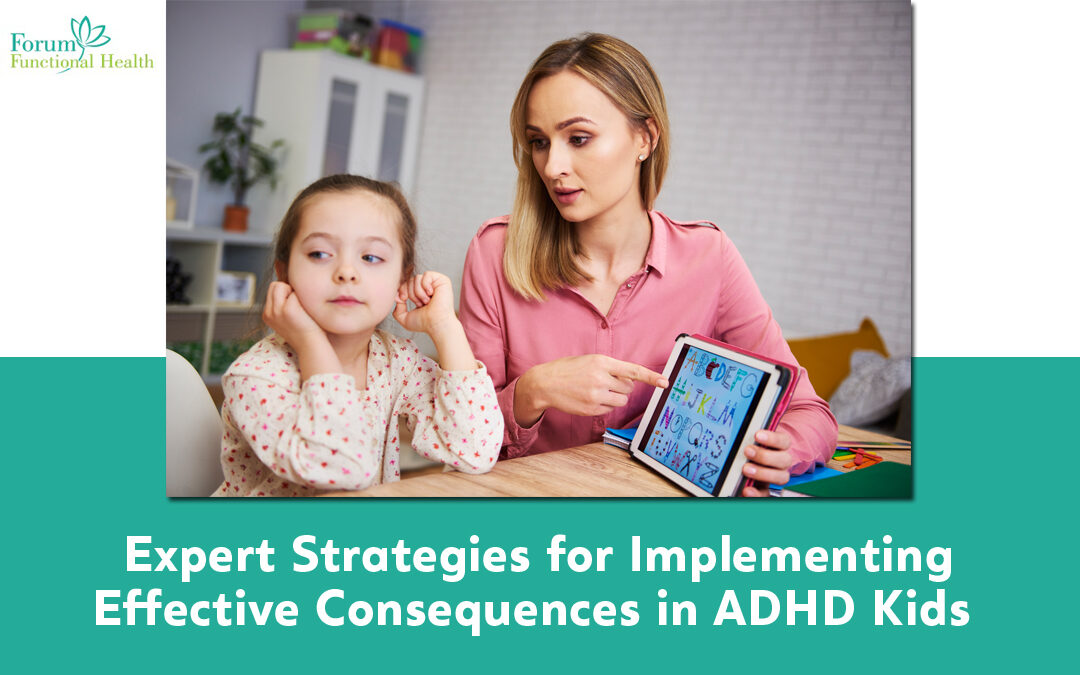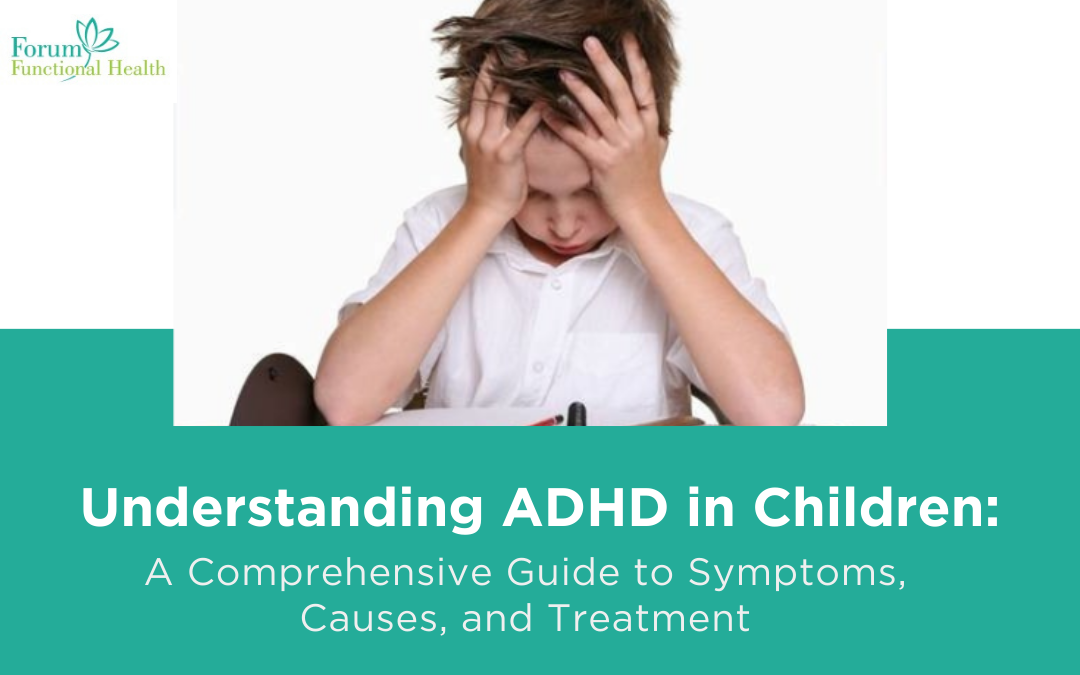
by Forum Functional Health Center | Jan 11, 2024 | Children with Hyperactivity & ADHD
Children with Attention Deficit Hyperactivity Disorder (ADHD) and those who look after them face unique problems in managing the condition. Behavioural strategies must be strategically applied in order to manage ADHD since they provide structure and foster healthy development. This article explores the use of behavioural strategies and, more especially, consequences that are carefully tailored to create an environment that supports the success of kids with ADHD.
Understanding ADHD and Behavioural Challenges
Attention Deficit Hyperactivity Disorder, or ADHD, is a condition that can affect both adults and children. It causes difficulties with organisation, attention, and impulse control, which can have an influence on social relationships and academic achievement, among other aspects of life.
It’s critical to offer kids with ADHD consistent and understandable behavioural tactics. These ought not to be harsh; rather, they ought to be guidelines for developing success-critical abilities. Effective behaviour and emotional regulation in children can be taught through the implementation of routines, expectations, and positive reinforcement.
Managing ADHD requires a structured atmosphere, which must be established. This entails keeping a regular daily schedule and providing a space set aside for work or study that is distraction-free. Tasks can be completed more successfully and with greater attention when broken down into smaller, more manageable steps. This helps to create an environment that is more regulated and organised.
Teaching self-regulation skills to those with ADHD is equally important. They are empowered to regulate impulsivity and improve attention span through practices including deep breathing exercises, mindfulness, and creating attainable goals. Task attention and decision-making abilities are gradually enhanced by the regular application of these techniques.
Creating a supportive environment
The first step in implementing behavioural tactics successfully is to create a supportive atmosphere. Children with ADHD feel more secure when there are clear expectations and consistent routines in place. Encourage a well-organised daily schedule that provides regularity to help reduce stress and impulsivity.
Adapting Penalties to ADHD
A key element of behavioural strategies is consequences. On the other hand, it’s critical to adjust punishments to the specific needs of the child when dealing with ADHD. Put more emphasis on consequences that foster self-awareness and learning than on punitive actions.
Adapting Discipline to ADHD Kids
A key element of behavioural strategies is consequences. On the other hand, it’s critical to adjust punishments to the specific needs of the child when dealing with ADHD. Put more emphasis on consequences that foster self-awareness and learning than on punitive actions.
Positive Reinforcement: Create a system of rewards to incentivize good behaviour. Employ a token or point system so that the child can receive incentives for finishing activities or acting in a way that is suitable. This encouraging feedback fosters self-assurance and motivation.
Time-Outs with Reflection: When disruptive behaviours occur, think about utilising time-outs as a chance for introspection rather than as a form of punishment. Give the youngster a moment to reflect on what they did and talk about other possible courses of action.
Collaborative problem-fixing: Engage the young person in conversations about fixing problems. Together, explore the negative effects of particular actions and come up with some better, more positive solutions.
Instant Feedback: Children with ADHD frequently gain from receiving immediate feedback. As soon as a behaviour happens, give feedback to help reinforce the link between behaviour and outcomes.
Implementing behavioural strategies:
Individualised Behaviour Plans: Create customised behaviour plans in collaboration with educators, therapists, and carers, taking into account the unique requirements and difficulties of each child. These plans ought to be flexible enough to change as the youngster develops.
Communication and Consistency: Develop open lines of communication between parents, teachers, and other professionals involved in the child’s care. This will help ensure consistency. Maintaining consistency in many settings aids in reinforcing behavioural standards, giving the youngster a solid basis.
Teaching Coping Skills: Equip ADHD children with coping skills to manage frustration and impulsivity. Teach them relaxation techniques, mindfulness, or simple exercises to redirect their focus during challenging moments.
Parental Involvement: Engage parents actively in the implementation of behavioural strategies. Provide resources, workshops, and ongoing support to help parents understand and effectively employ these strategies at home.
Developing effective consequences for ADHD children necessitates a deliberate and personalised approach. Carers and educators may help these children succeed by creating a supportive atmosphere, understanding the unique challenges of ADHD, and adopting a balanced mix of positive reinforcement and punishments. Consistency, open communication, and a collaborative approach become essential in fostering a favourable developmental trajectory for ADHD children, ultimately allowing them to thrive in various facets of their lives.
When it comes to providing Forum Functional Healthcare support for ADHD, a licenced functional medicine practitioner uses a comprehensive strategy to pinpoint possible hyperactive triggers. This entails investigating elements that are frequently linked to children’s hyperactivity, such as poor digestion, dietary and environmental allergens, abnormalities in fatty and amino acids, nutritional deficits, and heavy metal toxicity. Remarkably, data suggest that children who exhibit hyperactivity often get recurrent ear infections. Antibiotic therapy for certain diseases may result in dysbiosis, which can change the usual flora in the gut and cause inflammation in the brain. For complete ADHD management, addressing these underlying problems with practical healthcare measures becomes essential.

by Forum Functional Health Center | Dec 18, 2023 | Children with Hyperactivity & ADHD
Attention Deficit Hyperactivity Disorder (ADHD) is a neurodevelopmental disorder that affects millions of children worldwide. It is characterized by symptoms such as inattention, hyperactivity, and impulsivity, and can significantly impact a child’s academic performance, social relationships, and overall well-being. Understanding ADHD is crucial for parents, educators, and healthcare professionals alike, as early detection and intervention can greatly improve a child’s quality of life. In this comprehensive guide, we will explore the symptoms, causes, and treatment options for ADHD, providing valuable insights and practical strategies for managing this complex disorder.
What is ADHD and why is it important to understand it?
ADHD is a neurodevelopmental disorder that affects a child’s ability to pay attention, control impulsive behavior, and manage hyperactivity. It is a complex condition that can manifest in various ways, with symptoms varying from mild to severe. Understanding ADHD is crucial for several reasons.
Firstly, when parents, educators, and healthcare professionals have a comprehensive understanding of ADHD, they can recognize the symptoms early on and seek appropriate intervention. Early detection is vital for providing the necessary support and resources to help children with ADHD reach their full potential.
Understanding ADHD can help dispel misconceptions and reduce stigma. By promoting awareness and understanding, we can foster inclusive environments that support children with ADHD, allowing them to thrive in various aspects of their lives.
A thorough understanding of ADHD can guide treatment decisions. By knowing the different treatment options available, parents, educators, and healthcare professionals can collaborate to develop individualized plans that address the unique needs of each child with ADHD.
Recognizing the symptoms of ADHD in children
Recognizing the symptoms of ADHD in children is crucial for early intervention and providing the necessary support. While the symptoms can vary from child to child, there are some common signs to look out for.
One of the primary symptoms of ADHD is difficulty paying attention. Children with ADHD may struggle to concentrate on tasks, have a short attention span, and easily become distracted. They may also exhibit impulsive behavior, such as interrupting others or acting without thinking.
Another common symptom of ADHD is hyperactivity. Children with ADHD may have difficulty sitting still, constantly fidget, or feel restless. They may also talk excessively or have trouble participating in activities that require quiet and focused attention.
It is important to note that not all children with ADHD will display hyperactivity. Some children may predominantly demonstrate inattentive symptoms, such as being forgetful, losing things, or having difficulty organizing tasks.
The possible causes of ADHD in children
While the exact cause of ADHD is still unknown, researchers have identified several potential factors that may contribute to the development of this condition in children. It is believed that a combination of genetics, environmental factors, and brain structure plays a role in ADHD.
Genetics is considered to be one of the primary factors in ADHD. Studies have shown that children with a family history of ADHD are more likely to develop the condition themselves. Certain genes related to neurotransmitters, such as dopamine, have been found to be linked to ADHD.
Environmental factors can also influence the development of ADHD. Exposure to substances like tobacco smoke, alcohol, and drugs during pregnancy has been associated with an increased risk of ADHD in children. In addition, premature birth, low birth weight, and exposure to lead or other toxins in early childhood may also be contributing factors.
Brain structure abnormalities have been observed in children with ADHD. Brain regions responsible for attention, impulse control, and executive functions show differences in size and activity in individuals with ADHD. These differences may affect the communication between brain cells and the regulation of neurotransmitters.
The importance of early diagnosis and treatment
Early diagnosis and treatment play a crucial role in managing ADHD in children. Identifying the symptoms and getting a proper diagnosis at an early stage can significantly improve the child’s overall well-being and academic performance.
When ADHD is left untreated, it can lead to various challenges and difficulties for the child. These include academic struggles, impaired social relationships, and low self-esteem. However, with the right interventions and support, children with ADHD can thrive and reach their full potential.
Treatment for ADHD typically involves a combination of different approaches, including behavioral therapy, medication, and educational support. Behavioral therapy helps children develop and practice essential skills such as organization, time management, and self-regulation. Medications, such as stimulants or non-stimulants, may be prescribed in some cases to help manage the symptoms of ADHD.
Effective treatments for managing ADHD in children
In this section, we will explore the various effective treatments available for managing ADHD in children. Effective treatment strategies for ADHD often involve a combination of different approaches, tailored to suit the individual needs of each child. Here, we will delve deeper into each treatment option, examining their benefits, potential side effects, and how they can be integrated into a comprehensive treatment plan.
Behavioral therapy is a key component of ADHD treatment, helping children develop essential skills such as organization, time management, and self-regulation. We will discuss different types of behavioral therapy and how they can positively impact a child’s overall functioning. Additionally, we will explore the role of medication in managing ADHD symptoms, providing insights into stimulant and non-stimulant options, their effectiveness, and any potential side effects.
Education support is also essential for children with ADHD, so we will discuss how to create a supportive learning environment and implement strategies that can aid their academic success. Through this comprehensive approach, we can equip parents and caregivers with the knowledge and tools needed to effectively manage ADHD in children.
Supporting children with ADHD in educational settings
In this section, we will focus on the crucial role of education support in the lives of children with ADHD. Creating a supportive learning environment and implementing strategies that can aid their academic success is essential for their overall development.
We will explore different approaches that can be implemented in educational settings to support children with ADHD. One such approach is creating an individualized education plan (IEP) that identifies specific goals, accommodations, and modifications to meet the unique needs of the child. We will discuss how an IEP can provide structure, support, and necessary interventions to help children succeed academically.
Additionally, we will delve into the importance of effective communication and collaboration between parents, teachers, and other professionals involved in the child’s education. By establishing open lines of communication and working together, we can ensure consistent support and tailored strategies for the child.
We will provide practical tips for teachers to implement in the classroom, such as creating clear routines, incorporating movement breaks, and utilizing visual aids. These strategies can help children with ADHD stay focused, engaged, and maximize their learning potential.
Coping strategies for parents and caregivers
In addition to implementing educational support strategies in the school setting, it is important for parents and caregivers to also understand and employ coping strategies to support their child with ADHD.
Firstly, it is essential to educate yourself about ADHD and its impact on your child’s behavior and development. Understanding the symptoms, causes, and treatment options can help you better support and advocate for your child.
Next, establishing a consistent routine and structure at home can greatly benefit children with ADHD. Creating a predictable schedule and setting clear expectations can help reduce anxiety and increase their sense of control.
Furthermore, practicing effective communication with your child is key. Use clear and concise instructions, break tasks into smaller, manageable steps, and provide positive reinforcement for their efforts.
Additionally, encourage physical activity and provide outlets for their energy. Engaging in regular exercise or participating in sports and recreational activities can help channel their excess energy and improve focus.
Lastly, seek support from professionals, support groups, or other parents in similar situations. Sharing experiences and resources can help you navigate the challenges of parenting a child with ADHD and provide you with additional coping strategies.
Empowering children with ADHD for a successful future
In conclusion, understanding and actively implementing coping strategies can make a significant difference in the lives of children with ADHD. By educating yourself about the disorder and its impact, establishing consistent routines, practicing effective communication, encouraging physical activity, and seeking support, you can create a supportive and empowering environment for your child.
Remember, ADHD is not a barrier to success. With the right tools and support, your child can thrive and reach their full potential. By providing them with the resources they need and advocating for their needs, you are setting them up for a successful future.
Keep in mind that every child is unique, and what works for one may not work for another. It may take time to find the strategies that resonate with your child, but with patience and persistence, you can help them overcome challenges and develop the skills necessary for success.


